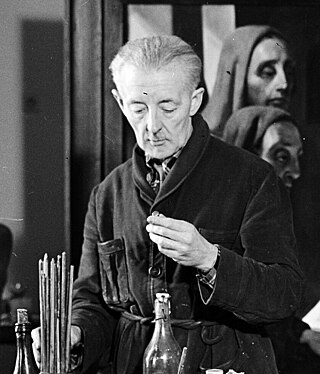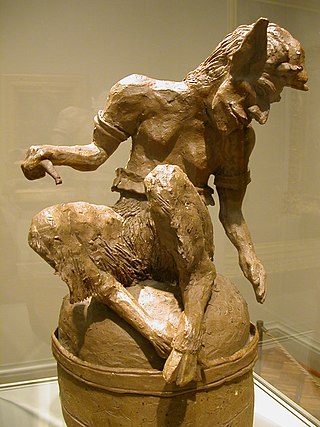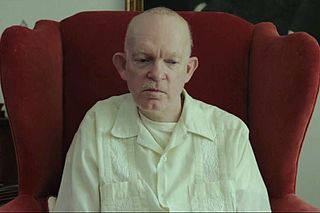Related Research Articles

Henricus Antonius "Han" van Meegeren was a Dutch painter and portraitist, considered one of the most ingenious art forgers of the 20th century. Van Meegeren became a national hero after World War II when it was revealed that he had sold a forged painting to Reichsmarschall Hermann Göring during the Nazi occupation of the Netherlands.
Eric Hebborn was an English painter, draughtsman, art forger, and later an author.

Konrad Paul Kujau was a German illustrator and forger. He became famous in 1983 as the creator of the so-called Hitler Diaries, for which he received DM 2.5 million from a journalist, Gerd Heidemann, who in turn sold it for DM 9.3 million to the magazine Stern, resulting in a net profit of DM 6.8 million for Heidemann. The forgery resulted in a four-and-half-year prison sentence for Kujau.

Art forgery is the creation and sale of works of art which are intentionally falsely credited to other, usually more famous artists. Art forgery can be extremely lucrative, but modern dating and analysis techniques have made the identification of forged artwork much simpler.
John Myatt,, is a British artist convicted of art forgery who, with John Drewe, perpetrated what has been described as "the biggest art fraud of the 20th century". After his conviction, Myatt was able to continue profiting from his forgery career through his creation of "genuine fakes".
Ely Sakhai is an American art dealer and civil engineer who owned Manhattan art galleries The Art Collection and Exclusive Art. He was later charged and convicted for selling forged art and was sentenced to 41 months in federal prison for fraud. After his release he continued to operate The Art Collection in Great Neck, New York.
David Stein was an artist who, until 1966, had been frequently sentenced for theft by the French courts before becoming an art forger and art dealer with 15 aliases. Stein studied the artworks of Marc Chagall, Matisse, Braque, Paul Klee, Miró, Jean Cocteau and Rouault.

Elmyr de Hory was a famed Hungarian-born painter and art forger. It is claimed he was responsible for producing over a thousand forgeries that were sold to reputable art galleries all over the world. His activities garnered celebrity from a Clifford Irving book, Fake (1969), and a documentary essay film by Orson Welles, F for Fake (1974).
William Blundell was an Australian painter and art copyist. He painted copies, which he called innuendos, for Sydney art dealer Germaine Marie François Toussaint Curvers.

Geert Jan Jansen is a Dutch painter and art forger, who was arrested in 1994.

F for Fake is a 1973 docudrama film co-written, directed by, and starring Orson Welles who worked on the film alongside François Reichenbach, Oja Kodar, and Gary Graver. Initially released in 1974, it focuses on Elmyr de Hory's recounting of his career as a professional art forger; de Hory's story serves as the backdrop for a meandering investigation of the natures of authorship and authenticity, as well as the basis of the value of art. Far from serving as a traditional documentary on de Hory, the film also incorporates Welles's companion Oja Kodar, hoax biographer Clifford Irving and Orson Welles as himself. F for Fake is sometimes considered an example of a film essay.

Incognito is a 1997 American crime thriller film directed by John Badham and starring Jason Patric and Irene Jacob. Written by Jordan Katz, the film is about a talented art forger who paints a fake Rembrandt despite pressure from his dying father who urges him to use his talent on his own original paintings. The film is notable for a sequence that reveals the specific details involved in forgery, including canvas aging, precise paints, and other deceptions.
Shaun Greenhalgh is a British artist and former art forger. Over a seventeen-year period, between 1989 and 2006, he produced a large number of forgeries. With the assistance of his brother and elderly parents, who fronted the sales side of the operation, he successfully sold his fakes internationally to museums, auction houses, and private buyers, accruing nearly £1 million.

The Faun is a sculpture by British forger Shaun Greenhalgh. He successfully passed it off as a work by Paul Gauguin, selling it at Sotheby's for £20,700 in 1994. Three years later, in 1997, it was bought by the Art Institute of Chicago for an undisclosed sum, thought to be about $125,000. It was hailed by them as "one of its most important acquisitions in the last twenty years."

The Spanish Forger is the name given to an unidentified individual who, in the late 19th to early 20th century, created a large number of forgeries of medieval miniatures.
William James Toye was an art forger in Baton Rouge, Louisiana. He painted in styles copied from Paul Gauguin, Pierre-Auguste Renoir and Alfred Sisley; Toye also copied the style of Claude Monet. Toye, his wife, and Robert E. Lucky, a New Orleans art dealer, were indicted on charges of conspiracy to commit mail fraud in 2010. On June 6, 2011, Toye pleaded guilty to conspiracy to sell counterfeit Clementine Hunter paintings, to misrepresenting the authenticity and origin of the paintings, and to painting the counterfeited Hunter artwork. William and Beryl Toye pleaded guilty to mail fraud charges in 2011 and were sentenced to two-years probation and ordered to pay $426,393 in restitution to the victims of the fraud. Robert Lucky was also convicted of mail fraud in January 2012 and was sentenced to 25 months in prison.

Mark Augustus Landis is an American painter who lives in Laurel, Mississippi. He is best known for donating large numbers of forged paintings and drawings to American art museums.
Wolfgang Beltracchi is a German former art forger and visual artist who has admitted to forging hundreds of paintings in an international art scam netting millions of euros. Beltracchi, together with his wife Helene, sold forgeries of alleged works by famous artists, including Max Ernst, Heinrich Campendonk, Fernand Léger, and Kees van Dongen. Though he was found guilty for forging 14 works of art that sold for a combined $45m (£28.6m), he claims to have faked "about 50" artists. The total estimated profits Beltracchi made from his forgeries surpasses $100m.
Beltracchi: The Art of Forgery is a 2014 film by Arne Birkenstock based on the life of German art forger Wolfgang Beltracchi.

David Henty is a former master forger. His works are renowned for the accuracy and authenticity with which he paints perfect copies of original works by master painters. Henty copies works by Caravaggio, Pablo Picasso, Amadeo Modigliani, Vincent Van Gogh, Jean-Michel Basquiat and others. Many of Henty’s forgeries have been sold by art dealers and auction houses as original works and are unknowingly included in many collections around the world. Having painted more copies of LS Lowry’s work than Lowry himself, Henty now operates on the right side of the law. His paintings regularly sell for thousands of pounds.
References
- 1 2 3 4 5 6 7 8 9 10 11 12 13 14 15 16 17 18 19 20 21 22 23 24 25 26 27 Paul Dean, "An Artist of Talent and, Some Say, Genius, Tony Tetro Is Charged With Forging the Works of Chagall, Miro, Dali. But He Claims Only to Be . . . : The Repro Man" Los Angeles Times (January 20, 1991). Retrieved June 19, 2011
- 1 2 Beatrice Tetro obituary Sun Sentinel (April 14, 2009). Retrieved June 19, 2011
- 1 2 3 4 5 6 7 8 9 10 11 Scott Hays, "Being Salvador Dali" Orange Coast Magazine (July 2000). Retrieved June 19, 2011
- 1 2 Philip P. Pan, "Forging Ahead : Art: Anthony Gene Tetro has made a name for himself by copying the works of others. Now he's busy on public safety projects as restitution--a novel if not original use of his talents" Los Angeles Times (August 12, 1993). Retrieved June 21, 2011
- 1 2 Terry Pristin, "A Chance Stroll Led to Suspect in Art Forgeries" Los Angeles Times (August 10, 1989). Retrieved June 20, 2011
- ↑ "Authentication in Art List of Unmasked Forgers".
- ↑ Terry Pristin, "Claremont Man Charged With Forging Artwork" Los Angeles Times (August 5, 1989). Retrieved June 21, 2011
- ↑ "Man Pleads Not Guilty to Forging Artists' Works" Los Angeles Times (June 22, 1990). Retrieved June 21, 2011
- 1 2 Terry Pristin, "Mistrial Is Declared in Art Forgery Case : Courts: Jury deadlocks on charges against a man who copied paintings by prominent artists. He denies conspiring to pass off the fakes as authentic." Los Angeles Times (June 11, 1991). Retrieved June 20, 2011
- 1 2 "Convicted Art Forger Ordered to Paint Mural" Los Angeles Times (April 21, 1993). Retrieved June 20, 2011
- ↑ "How to forge a masterpiece" BBC Focus Magazine. Retrieved June 19, 2011
- ↑ John Leonard, "Television: The Fighting Irish" New York magazine (December 16, 1991), p. 62. Retrieved June 20, 2011
- ↑ Moore, Ninah.(2024).Tetro, Tony and Giampiero Ambrosi, Con/Artist: The Life and Crimes of the World’s Greatest Art Forger Narrated by Richard Ferrone, Tony Tetro and Giampiero Ambrosi. Hachette Audio.2024 RUSA Listen List Revealed. American Library Association, January 20, 2024.
- ↑ "Want to win a Warhol?". Art Series Hotels. Retrieved 2012-06-03.
- ↑ Gina McColl (24 May 2012). "Warhol stunt turns into 15 minutes of infamy". Sydney Morning Herald. Retrieved 2012-06-03.
- ↑ "Forger Claims Credit for Paintings in Prince Charles's Charity Headquarters". The New York Times. November 4, 2019. Retrieved July 17, 2022.
- ↑ Seal, Mark (February 20, 2020). "The Prince, the Flash, and the Forger". Vanity Fair. Retrieved July 17, 2022.